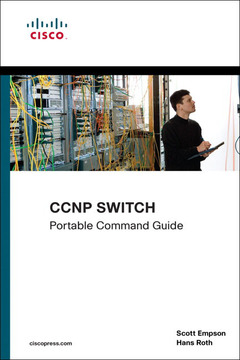Description
Ccnp switch portable command guide (1st ed )
Authors: EMPSON Scott, ROTH Hans
Language: English
Approximative price 28.23 €
In Print (Delivery period: 12 days).
Add to cart168 p. · 15.2x22.9 cm · Paperback
Description
/li>Contents
/li>
CCNP is now the second most common Cisco certification. Its three exams cover more advanced routing and switching topics than CCNA, and now includes both security and wireless. The CCNP® SWITCH Portable Command Guide is the ideal supplementary guide for every network administrator who wants to pass the 2009 Implementing Cisco Switched Networks (SWITCH) CCNP exam. Quick, lightweight, and filled with realistic configuration examples, it summarizes all the commands, keywords and optional sub-commands, command arguments, and associated prompts covered on the CCNP SWITCH exam. The book contains both network diagrams and command outputs, showing all the commands needed to build real-world networks, where to use each command, and why. Like all books in the CCNP Portable Command Guide series, this book is designed as a simplified "Engineering Journal" of commands for beginning-to-intermediate level administrators. Designed to map directly to each CCNP SWITCH exam objective, it enables you to study anywhere, even if you don't have an Internet connection - and without having to carry around a large, heavy book. You immediately see a "What do you want to do" section pointing you to the specific topics, chapters, and pages they're looking for - making this book an ideal resource for solving real network problems, not just preparing for the exam.
- Fast, authoritative Cisco switching command review that maps directly to the newest (2009) CCNP SWITCH exam
- Includes realistic configuration examples, network diagrams, and command outputs: all readers need to understand the "how" and "why" of essential SWITCH commands
- Convenient, lightweight, and friendly: lets readers study without a huge textbook or a live Internet connection
Module 2: Implementing VLANs in Campus Networks
Module 3: Implementing Spanning Tree
Module 4: Implementing Inter-VLAN Routing
Module 5: Implementing High Availability in a Campus Environment
Module 6: Implementing a First Hop Redundancy Protocols Solution
Module 7: Minimizing Service Loss and Data Theft in a Campus Network
Module 8: Integrating Wireless LANs into a Campus Network
Module 9: Accommodating Voice and Video in Campus Networks




